"January Thaw"
As we continue to head through the 2nd half of January, mild temperatures continue as well. MN State Climatologist Mark Seeley talks about how the probability of temperatures warming above the freezing mark in January.
"The proverbial "January Thaw" (two or more consecutive days with daily high temperatures greater than freezing) for the Twin Cities has historically about an 80 percent probability of occurrence (about a 91 percent probability since 1980 with a pronounced urban heat island effect). This January it is happening to us with an exclamation mark! We may have up to 10 consecutive days with daily high temperatures above freezing if the forecast through January 26th verifies. In this context it would be the 5th longest such streak in the Twin Cities climate records surpassed only by 18 days in January 1944, 15 days in January 1942, 13 days in January 1919, and 11 days in January 1880 and 1909. (thanks to NOAA's Michelle Margraf and DNR-SCO's Pete Boulay for pointing this out)."

Golf in January? Sure, Why Not.
Well if you're itching to get out and swing the clubs, Bunker Hills Golf Club in Coon Rapids is an option. They've opened their outdoor driving range and says they'll be open as long as the weather allows...
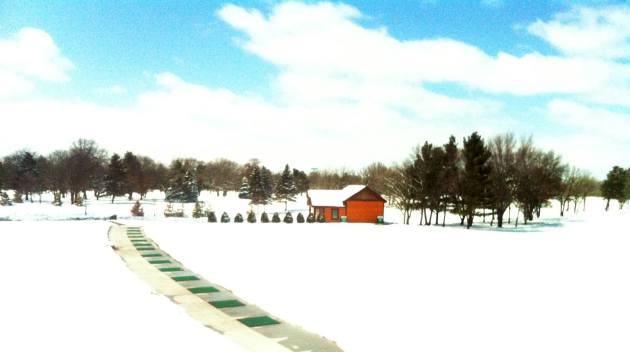
________________________________________________________________________
Hockey Day In Minnesota - Saturday, January 21st
One of my favorite days of the year is coming up this weekend! Weather conditions for Hockey Day in Minnesota over the years have ranged from brutally cold with frigid wind chills to picture perfect with light snow. This year's event will be held in Stillwater, located along the beautiful St. Croix River and while the setting couldn't be any more beautiful... unfortunately, the weather this Saturday looks a little ugly. High temperatures are expected to be near 40 degrees with a chance of a little light rain.
(Image below courtesy @HockeyDayMN)
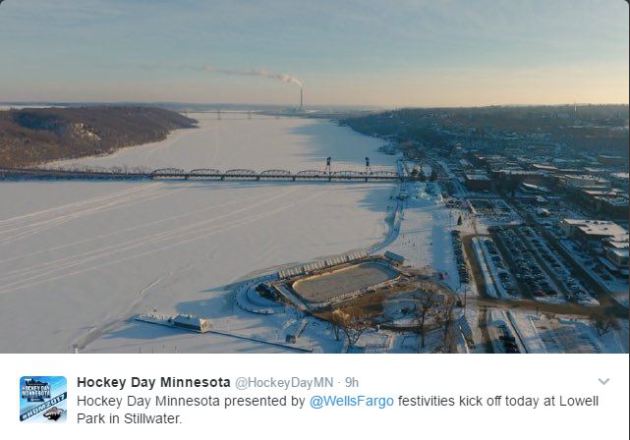
If you're interested in what's happening in downtown Stillwater, here's a LIVE webcam from Stillwater.com showing the the hockey rink and ice castle in Stillwater’s Lowell Park.
Temperature Outlook Saturday
Here's the temperature outlook for Saturday, which shows high temperatures across the southern half of Minnesota in the low/mid 40s, which nearly 20F above average! High temperatures like this are more typical of mid March!
Weather Outlook for Saturday
Here's the weather outlook from Friday night to Saturday night, which shows scattered light rain showers rotating through the region. The storm system responsible for this somewhat soggy weather will also be responsible for temperatures in the low/mid 40s, which will be nearly 20F above average for mid/late January.

Precipitation Potential
Here's the precipitation potential through Wednesday, which shows fairly impressive precipitation amounts across parts of the state.. Note that temperatures will be warm enough for mostly rain over the weekend. Another system develops Tuesday and Wednesday and temperatures may be cold enough for snow.

Increasing Snow Chance Early Next Week
A storm system looks to develop early next week with the potential of widespread snowfall accumulations. While it is still too early to talk numbers, weather models continue to hint at the potential of some shovel amounts across the region. Stay tuned...
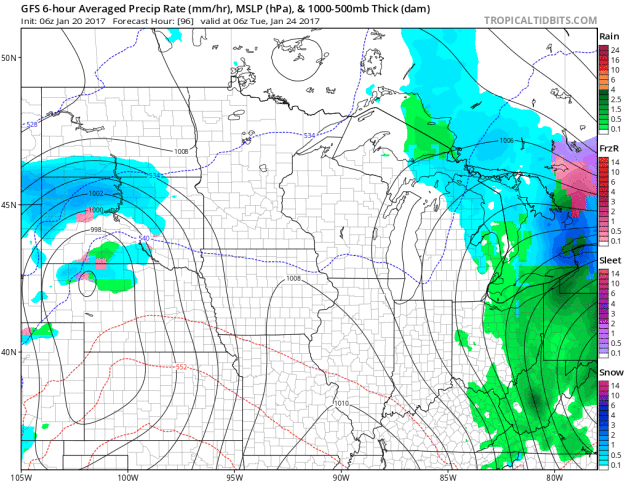
Soggy Hockey Day in Minnesota - Feels Like March
Drip, drip drip... The sound you hear is that of an abnormally warm mid winter rain. Not sure about you, but I thought January was host to face-numbing wind chills and fluffy snow. Looking at the non frozen and puddly landscape, I'm wondering when we time warped to March.
Temperatures warm to near 40 degrees again today, which will be near 15 to 20 degrees above average. Hockey Day in Minnesota festivities will limp along today, but despite the unfriendly weather, the state of hockey will still celebrate its rich heritage.
Mild temps and lingering light rain showers continue through the weekend. The mercury may dip just enough to coax a few wet flakes out the clouds on Sunday, but nothing will stick. We'll have a better chance of snow sticking early next week as a Pacific storm system moves into the Upper Midwest. Temps look fairly mild initially, which could make for sloppy event. Stay tuned.
March-like temps now give way to more January-like temps later this week. NOAA's February outlook looks colder and snowier.
___________________________________________________________________________
___________________________________________________________________________
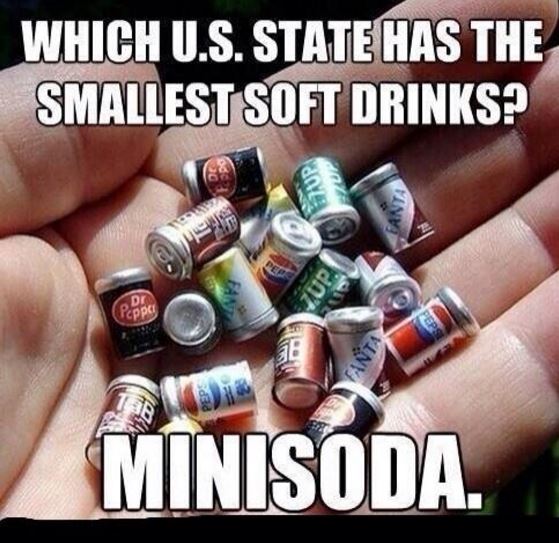
Extended Forecast:
FRIDAY NIGHT: Patchy fog and drizzle. Winds: ESE 5. Low: 36.
SATURDAY: Mild with scattered showers. Winds: E 5. High: 39.
SATURDAY NIGHT: Scattered sprinkles & light rain. Winds: SE 5. Low: 33
SUNDAY: Stray sprinkles or wet flakes. Winds: NW 5-10. High: 39.
MONDAY: Mostly cloudy. Still warm for January. Winds: W 5. Wake-up: 31. High: 39.
TUESDAY: Light snow develops late. Winds: ENE 10-15. Wake-up: 30. High: 37.
WEDNESDAY: Breezy. Wet snow continues. Winds: NNW 10-20. Wake-up: 30. High: 36.
THURSDAY: Cold with lingering flurries. Winds: NW 10-15. Wake-up: 25. High: 30.
FRIDAY: Clipper arrives late. PM snow. Winds: WNW 10-15. Wake-up: 20. High: 29.
_______________________________________________________________________________
_______________________________________________________________________________
This Day in Weather History
January 21st
January 21st
1936: Warroad drops to a bone-chilling 55 below zero.
1922: The barometer at Collegeville hits 31.11 inches, a record high pressure reading for the state.
_______________________________________________________________________________
_______________________________________________________________________________
Average High/Low for Minneapolis
January 21st
January 21st
Average High: 24F (Record: 48F set in 1900)
Average: Low: 7F (Record: -41F set in 1888)
Average: Low: 7F (Record: -41F set in 1888)
*Record Snowfall: 15.8" set in 1917
_______________________________________________________________________________
_______________________________________________________________________________
Sunrise Sunset Times For Minneapolis
January 21st
January 21st
Sunrise: 7:43am
Sunset: 5:06pm
Sunset: 5:06pm
*Daylight Gained Since Yesterday: ~2 minutes & 8 seconds
*Daylight Gained Since Winter Solstice (December 21st): ~37 minutes
________________________________________________________________________________
*Daylight Gained Since Winter Solstice (December 21st): ~37 minutes
________________________________________________________________________________
Moon Phase for January 20th at Midnight
1.4 Days After Last Quarter
1.4 Days After Last Quarter

________________________________________________________________________________
Weather Outlook For Saturday
Saturday will be another very mild day with highs warming into the upper 30s to near 40F. Note that this will still be nearly 15F to 20F years.
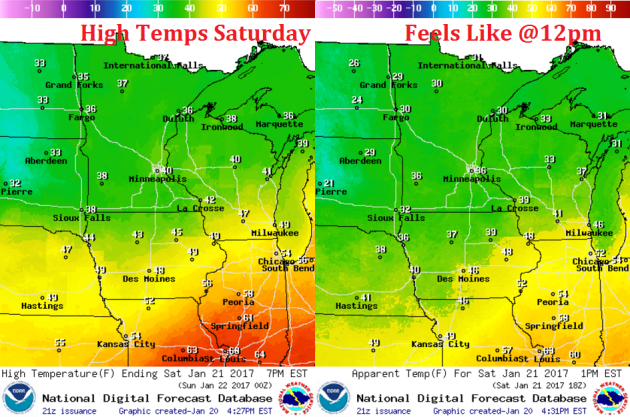
Weather Outlook For Saturday
A light east to southeasterly breeze continues Saturday as a weak storm system pushes through the region.
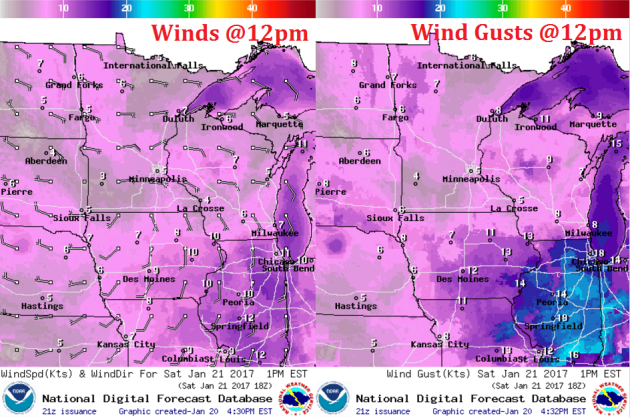
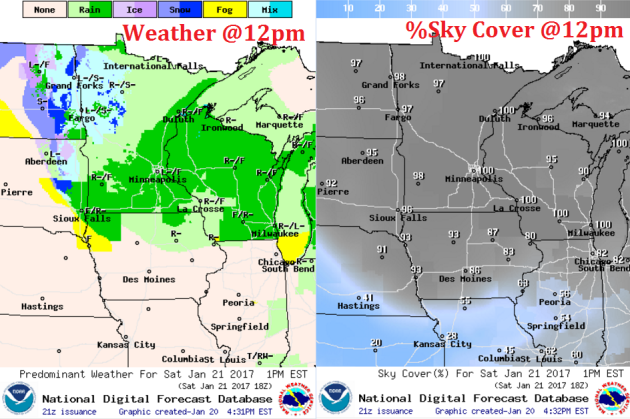
Here's the temperature outlook through January 29th, which shows a VERY mild trend heading into the weekend and into early next week with highs in the 30s and 40s! With several days above freezing, our snow pack will continue to take a big hit... fog concerns will also be an issue with melting snow and added moisture in the lower levels of the atmosphere. By the end of the end of next week, temperatures get a little closer to average.

___________________________________________________________________________________
8 to 14 Day Temperature Outlook
According to NOAA's CPC, the 8 to 14 day temperature outlook suggests warmer than average temperatures continuing across much of the Upper Midwest from January 30th to February 3rd. There may be a slight cool down late next week, but the overall trend remains warmer than average.
_________________________________________________________________________________
Temperature Outlook
National Temp Outlook
Take a look at the temperature anomaly through Thursday, January 26th. Note that the Eastern half of the country looks to stay warmer than average through much of that time period, but colder than average temps begin moving into the Western & Central U.S. by the middle/end of next week.
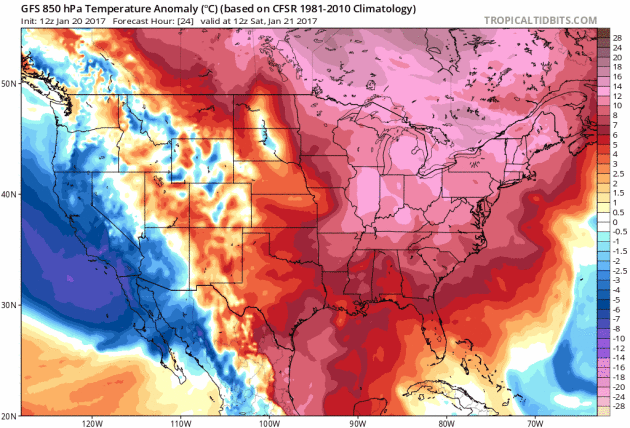 ________________________________________________________________________________
________________________________________________________________________________
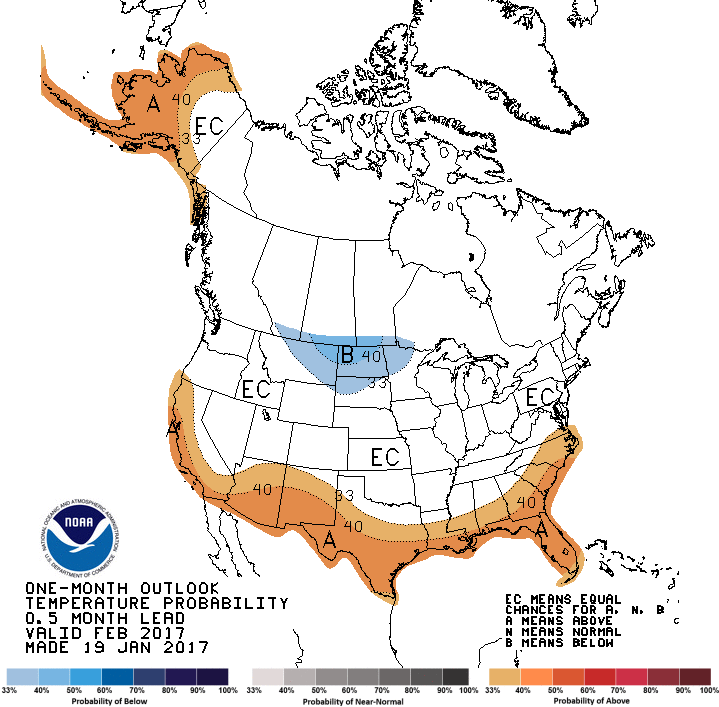
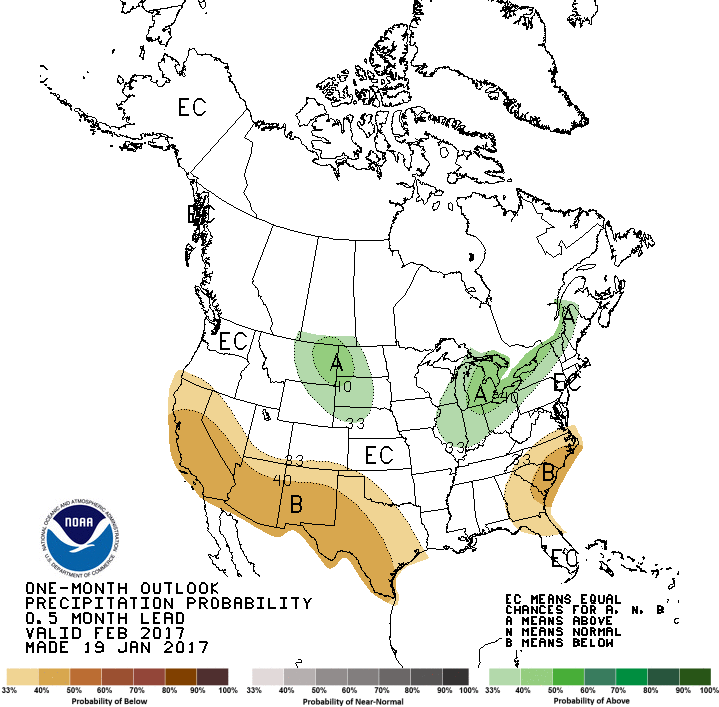

February Outlook
NOAA's CPC released their February outlook, which shows that much of the will have equal chances of above and below normal temperatures with the exception of Alaska and the southern tier of the nation. The only spot that looks to be below average is the High Plains and Upper Midwest. Note that above average temperatures look to be found across the northern tier of the nation, while below average precipitation looks to be found along the southern tier of the nation.


Thundery Outlook In the Southeast Through The Weekend
Heres' the simulated radar from Saturday to Monday morning, which shows ongoing showers and storms across parts of the Gulf Coast States. Widely scattered strong to severe storms may include damaging winds and tornadoes. There may also be flooding rains through Sunday.
.gif)
Here's the severe weather outlook for Saturday and Sunday, which shows the severe weather concern continuing across parts of the Southeastern U.S.. Strong to severe storms may be capable of large hail, damaging winds and even tornadoes.
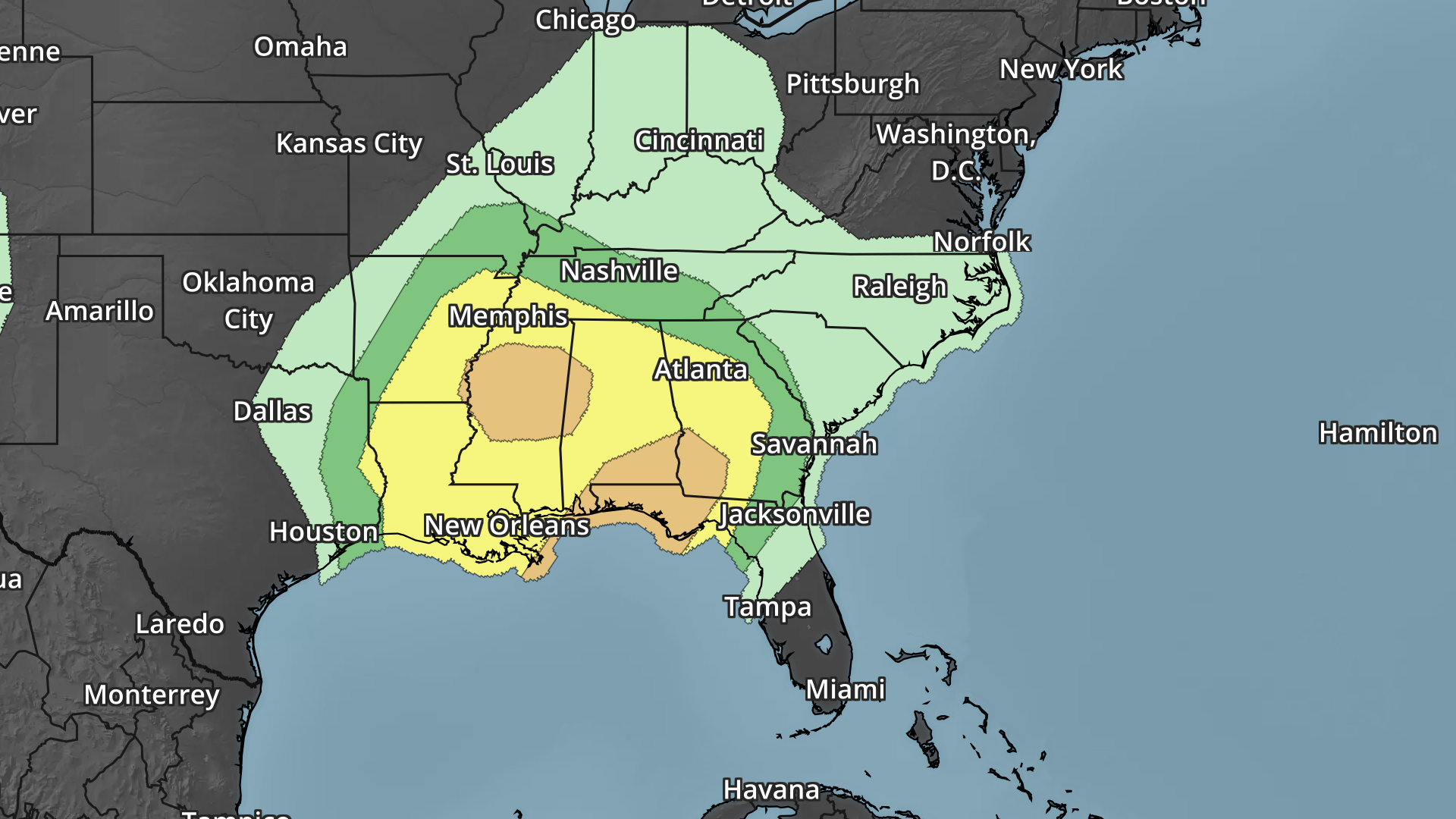
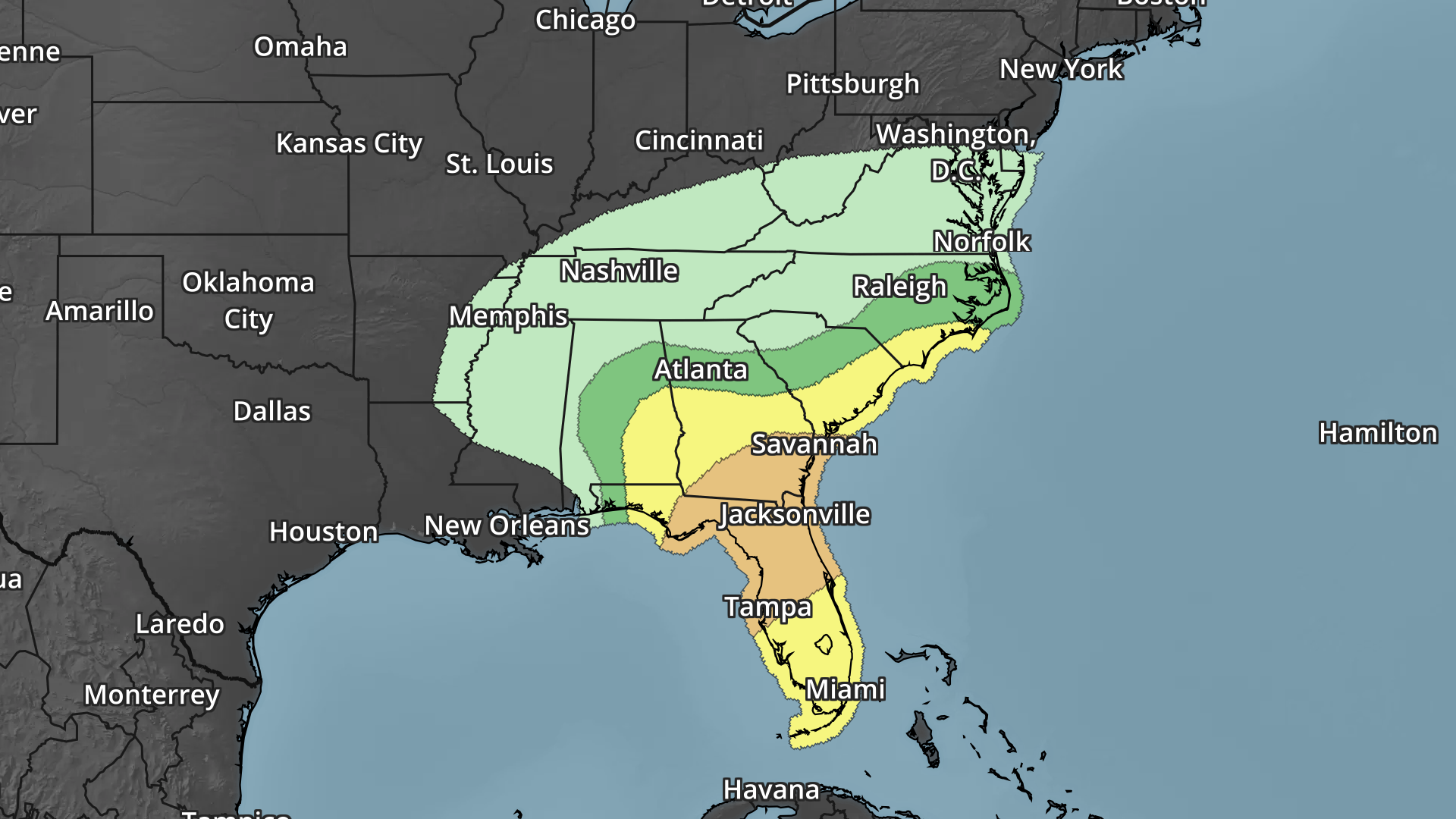
Heavy Rain Threat Ahead
Scattered showers and storms will continue across the Southeastern U.S. through the weekend with the potential of heavy rainfall and flooding. Some spots through PM Sunday could see 2" to 4"+
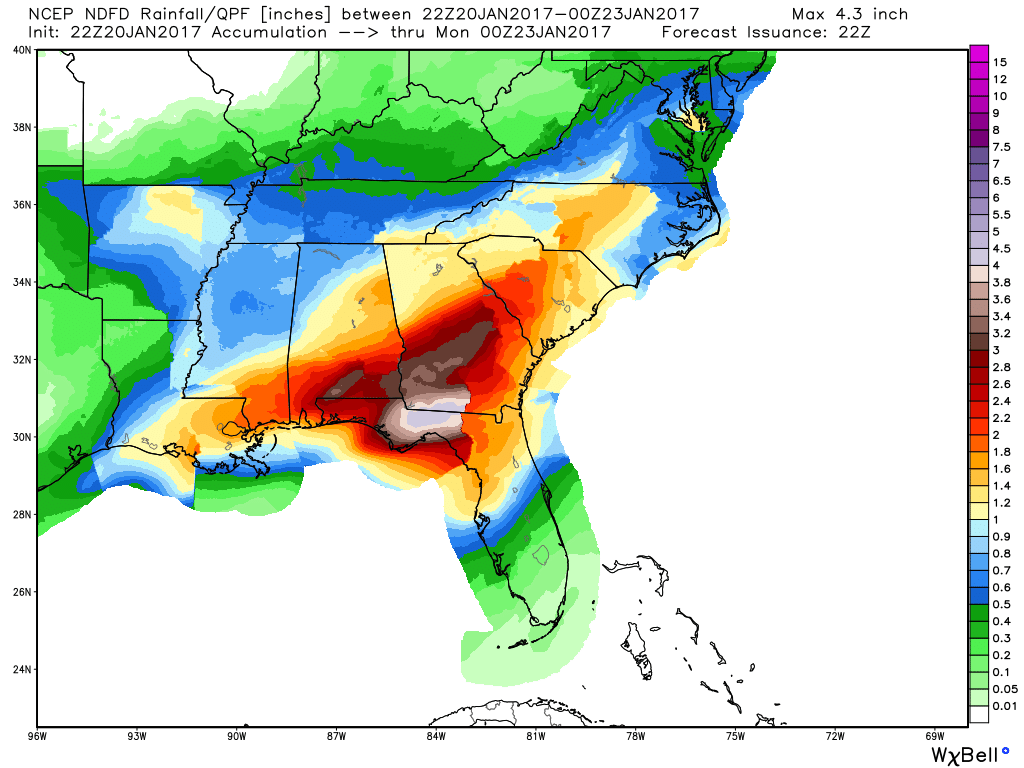 _____________________________________________________________________________
_____________________________________________________________________________Snowfall has been most impressive across parts of the Western U.S. with some spots seeing feet of snow over the last several weeks. Take a look at this picture from Yosemite National Park where nearly 2ft of snow has fallen in the past week. Here's an excerpt from Yosemite Conservancy, which says that the Central Sierra snow water equivalent is at 150% of normal for this time of year.
"The latest update from Yosemite's winter rangers! More than 2 feet of snow fell in the high country over the past week. As of yesterday, Central Sierra snow water equivalent is at 150% of normal for this time of year (for the latest snowpack info, check out the CA Data Exchange Center: cdec.water.ca.gov/snow/current/snow/)."
Tuolumne Meadows Ski Hut - January 12, 2017.
Take a look at how impressive the 30 day precipitation tallies are across the West Coast. Note the purple colors that indicate 12" of liquid! Some spots have quite a bit more than that and there's more precipitation on the way!
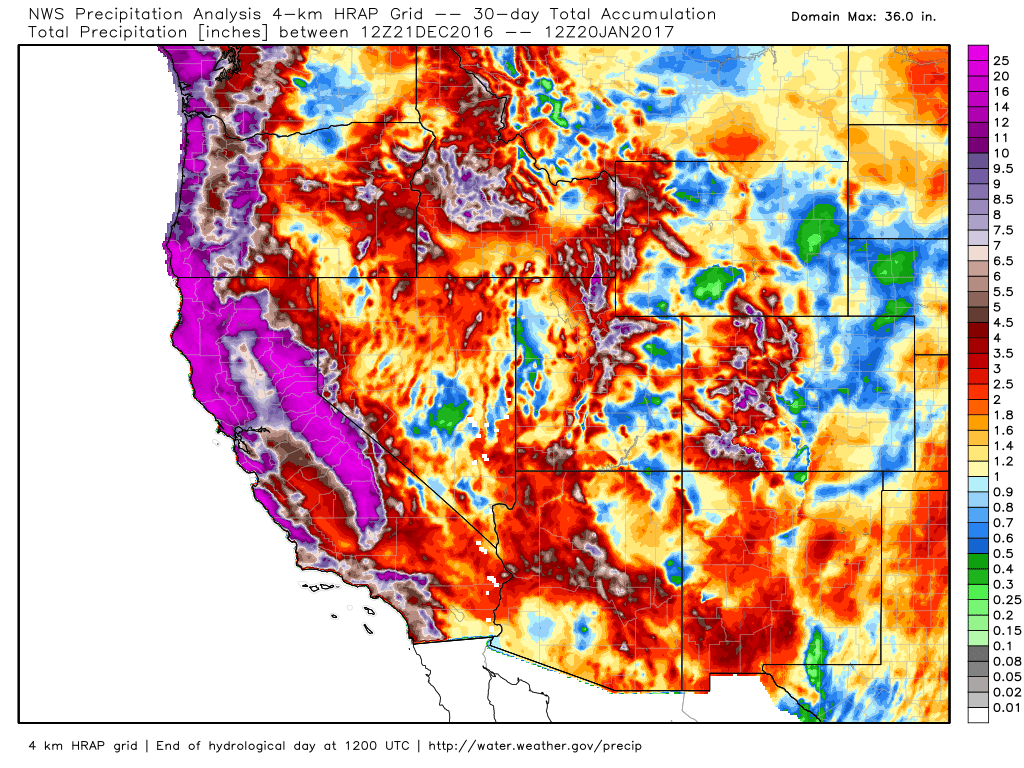
Improving California Drought
According to the U.S. Drought Monitor, the California drought continues to improve. Note that from last week to this week, there was more improvement in the Extreme and Severe drought. WIth the additional moisture late last week and through the next several days, we should continue to see even more improvement!
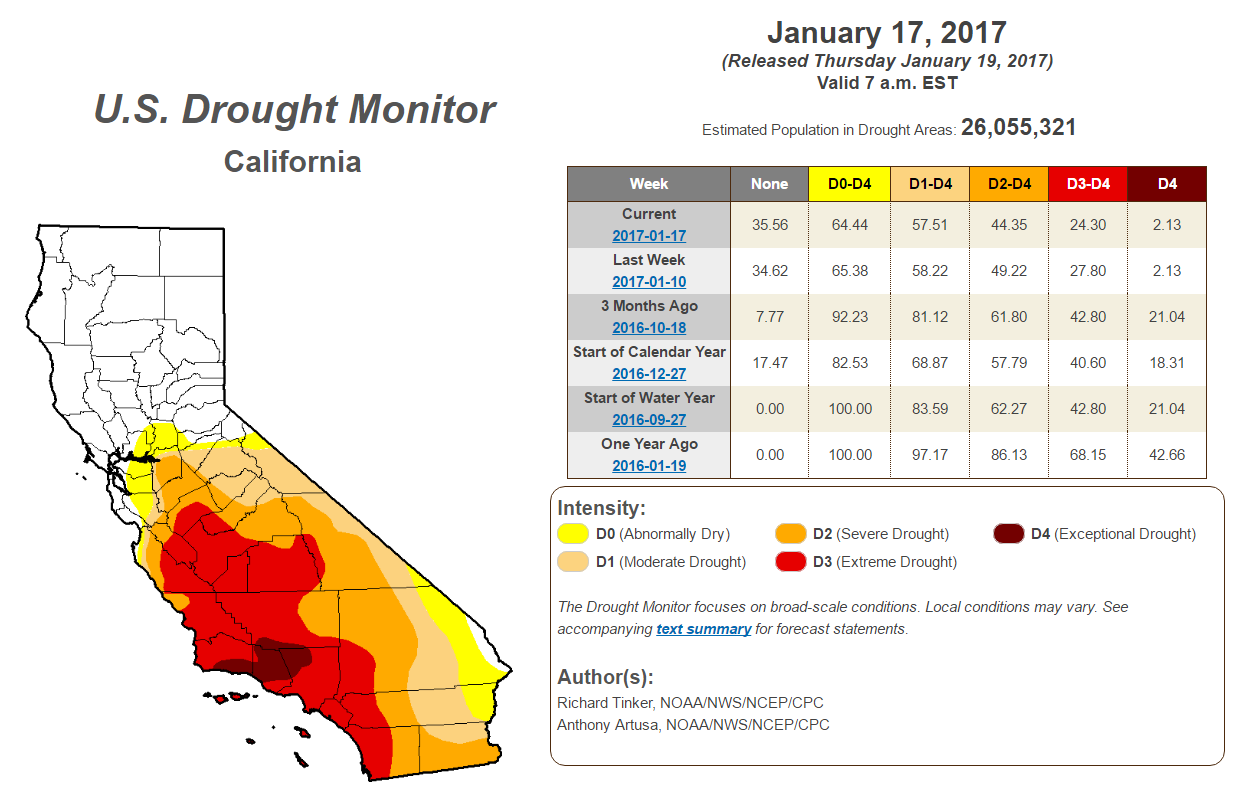
Atmospheric Rivers Continue...
Heavy precipitation has been falling across the Western U.S. due to rivers of Pacific moisture plowing into the region. Note the deep plumes of Pacific moisture that seems to be directed right toward the West Coast, these are the Atmospheric Rivers that are responsible for the extensive precipitation.

Waves of Pacific Moisture in the Western U.S. Continue
Several rounds of heavy precipitation have blasted the West Coast and we're not quite done yet. Another surge of heavy precipitation will push through the region the weekend and early next week with significant rainfall and flooding along with heavy mountain snow.
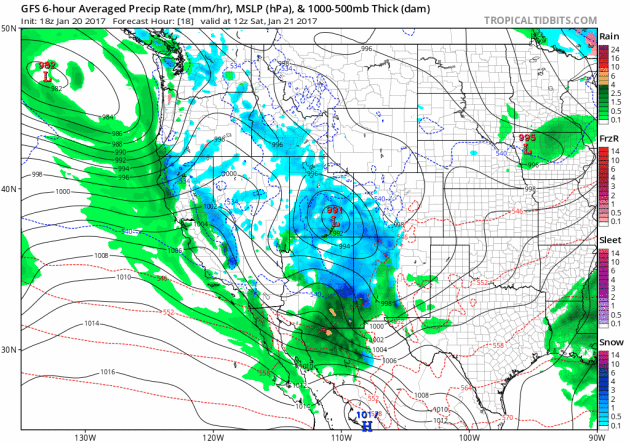
Western Winter Weather Concerns
A number of winter weather headlines continue across the Western U.S. over the next few days with 1ft. to 2ft. possible in some of the most extreme cases. Also note that the mountains near Los Angeles and southern Arizona are under winter storm warnings, where up to 1ft of snowfall will be possible through the weekend.
Snowfall Potential
Here's the snowfall potential through early next week, which shows widespread heavy mountain snow. Another 1ft to 2ft.+ can't be ruled out across the Sierra Nevada Range, while heavy snow may also be possible in the mountains across southern California and into Arizona.
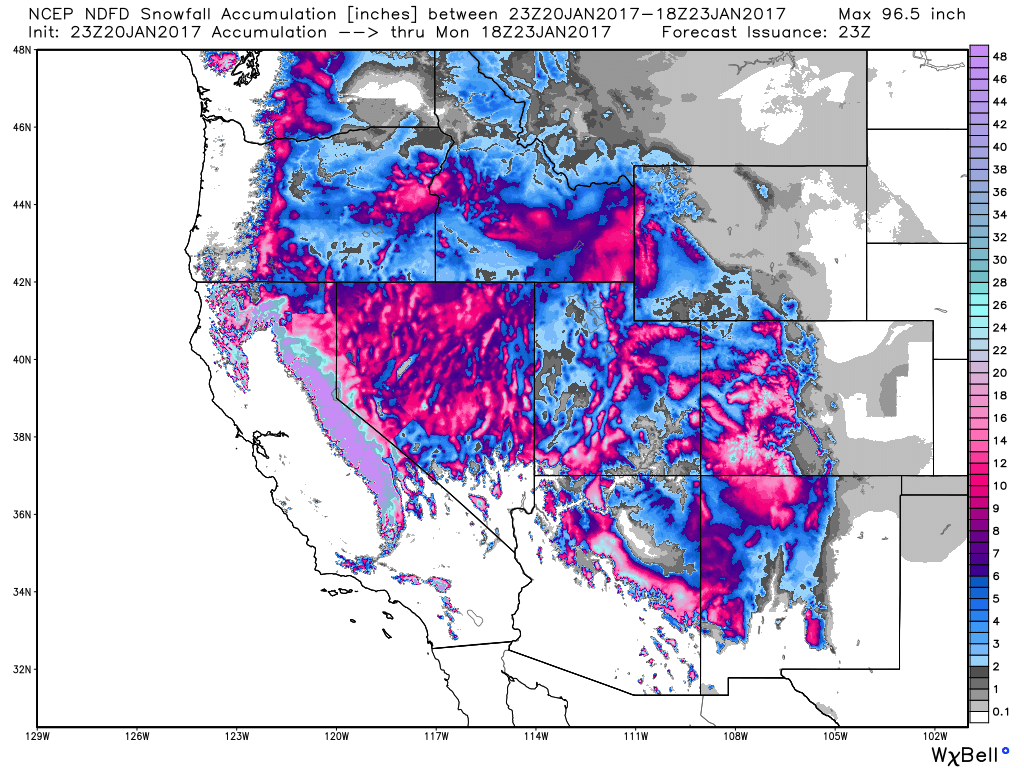
Here's the national weather outlook through the early weekend, which shows scattered storms and locally heavy rainfall continuing and redeveloping across the Gulf Coast States. Note that some of the storms late week and into the weekend could be severe. The Western U.S. will also be inundated with widespread heavy precipitation over the next several days. Heavy rain, flooding and heavy mountain snow will be possible as several rounds of Pacific moisture "Atmospheric Rivers" move through during the end of the week, weekend ahead and into early next week.
 5 Day Precipitation Forecast
5 Day Precipitation Forecast
Here's the snowfall potential through early next week, which shows widespread heavy mountain snow. Another 1ft to 2ft.+ can't be ruled out across the Sierra Nevada Range, while heavy snow may also be possible in the mountains across southern California and into Arizona.

National Weather Outlook

According to NOAA's PC, the 5 day precipitation forecast suggests widespread 2" to 4"+ rainfall amounts across the Southern and Eastern U.S.. Also note the heavy moisture moving back into the West U.S., especially along the West Coast. Some 6" to 12"+ liquid tallies can't be ruled out from northern California to western Oregon and western Washington. There may even be some 3" to 6"+ tallies across parts of southern California through early next week.

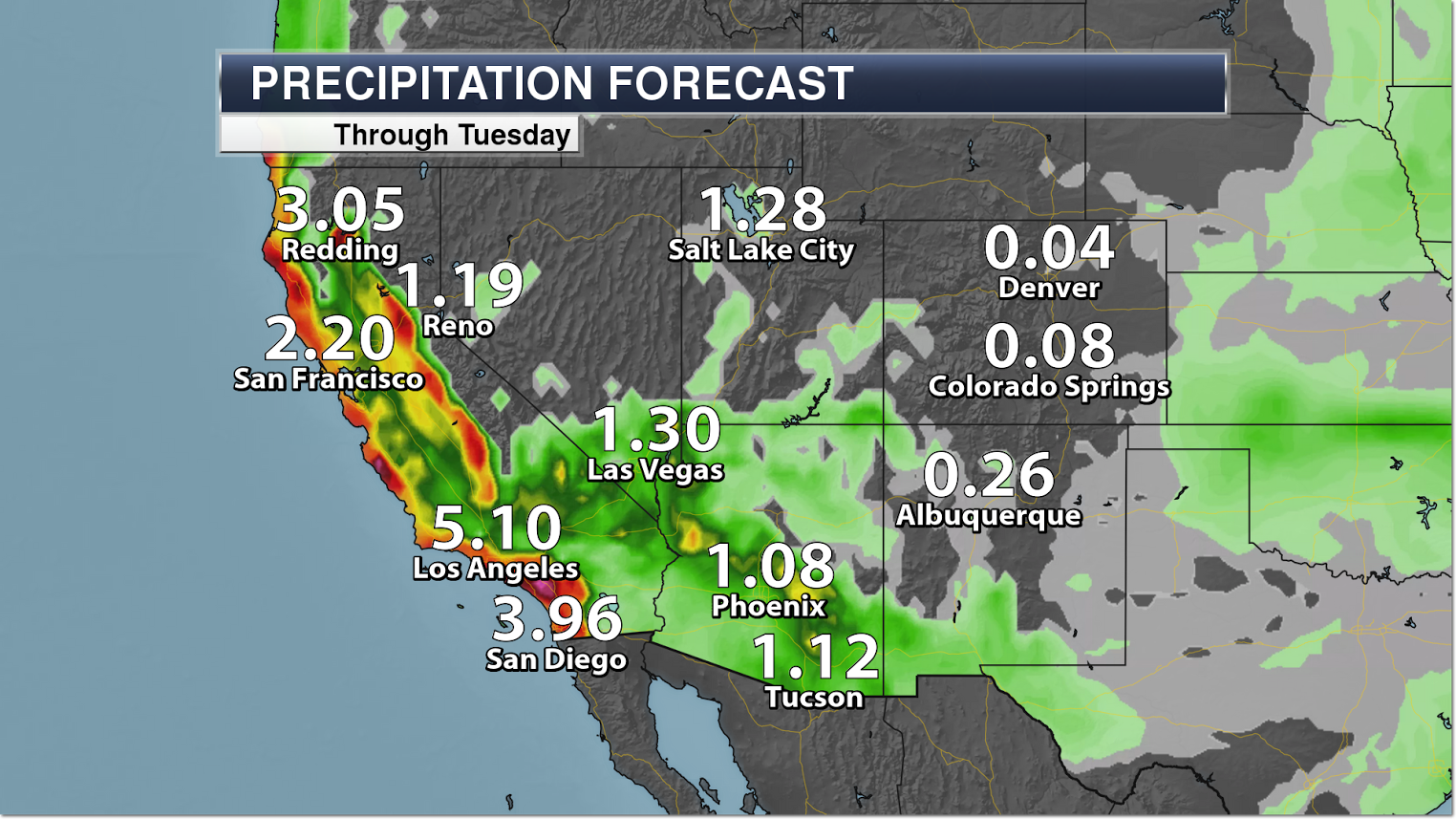 _________________________________________________________________________________
_________________________________________________________________________________
"NPS May Send Pack Of Wolves To Isle Royale"
:Down to just two wolves in the past five years, a new plan hopes to revitalize the presence of alpha carnivores in the dynamic island habitat off the northern coast of Minnesota.A National Park Service plan hopes to introduce up to 30 wolves to Isle Royale in Lake Superior. The topic is open for public comment until March 15."
(Image Credit: GearJunkie via Flikr/Barnaby_S)

"NOAA and the new administration: Will Trump make America’s weather model great again?"
America’s primary computer model for predicting the weather is not as accurate as the Europeans’. Many meteorologists and lawmakers lament that the United States has fallen behind Europe in global weather modeling. Could the incoming Trump administration, which has placed a real emphasis on U.S. competitiveness, try to put the United States back on top in the world of weather modeling? What might be some of President-elect Donald Trump’s other key priorities within the National Oceanic and Atmospheric Administration?
{GFS model simulation of Superstorm Sandy in 2012. (WeatherBell.com)}
"Climate Change May Reduce Some U.S. Grain Harvests by Half"
*Scientists developed computer model to show effect on crops
*Corn, soybean yields may lose 40%-50% by end of the century
*Corn, soybean yields may lose 40%-50% by end of the century
Some of the most important U.S. crops, from wheat to soybeans, are at risk of substantial damage from climate change. Higher temperatures may cut the wheat harvest by 20 percent by the end of the century without efficient carbon reductions, according to a study by researchers including the Potsdam Institute for Climate Impact Research and the University of Chicago. Yield reduction could reach 40 percent for soybeans and almost 50 percent for corn, relative to non-elevated temperatures, the group said in a report released Thursday. "The effects go far beyond the U.S., one of the largest crop exporters," the researchers said. "World market crop prices might increase, which is an issue for food security in poor countries."
See more from Bloomberg HERE:
(Image credit: Bloomberg)
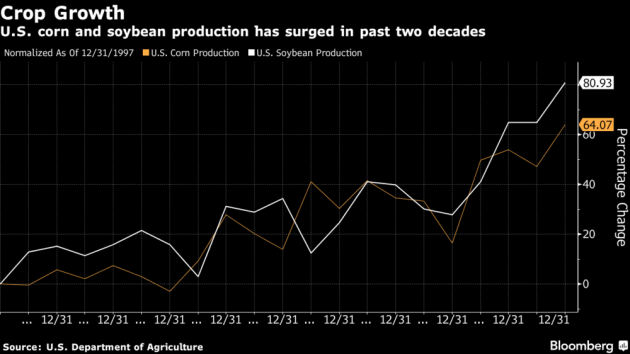
See more from Bloomberg HERE:
(Image credit: Bloomberg)
___________________________________________________________________________________
"Avalanches are becoming more common, thanks to climate change, researchers say"
"An avalanche buried an Italian resort on Wednesday, leaving at least 30 people trapped inside and scores likely dead. Officials link the immediate cause to earthquakes in central Italy. But scientists say there's another reason that snow slides are becoming more common: climate change. Avalanches are caused by a combination of geological factors (like the incline of a mountain or natural events like earthquakes), weather and the structure of the snow. Warmer weather can weaken a mountain's snow pack and make it more difficult for the layers of snow to stick together. Mix in another element, like particularly gusty wind or trembling earth, and you've got a mountain primed for avalanche."
{A hotel in central Italy was hit by an avalanche, leaving 30 people likely buried under the snow. (Reuters)}
 _______________________________________________________________________________
_______________________________________________________________________________
"The huge crack in this Antarctic ice shelf just grew by another 6 miles"
"A crack more than 100 miles long in one of Antarctica’s largest ice shelves grew another 6 miles in a little more than two weeks this month, British scientists reported Thursday. That’s on top of an 11-mile growth that occurred in the second two weeks of December — representing a 17-mile total advance in not much more than a month. The extension of the rift in the Larsen C ice shelf ran roughly parallel to the ocean-terminating front of the floating ice shelf, and so, did not bring it any closer to breaking off a large piece — 12 miles of ice still connect the emerging ice island to the larger shelf. But the parallel growth may ensure that the iceberg, when it does break off, will be somewhat larger."
{A Nov. 10 photo made available by NASA shows a view of a massive rift in the Antarctic Peninsula’s Larsen C ice shelf, Antarctica. (John Sonntag/NASA via European Pressphoto Agency)}

Thanks for checking in and don't forget to follow me on Twitter @TNelsonWX

No comments:
Post a Comment